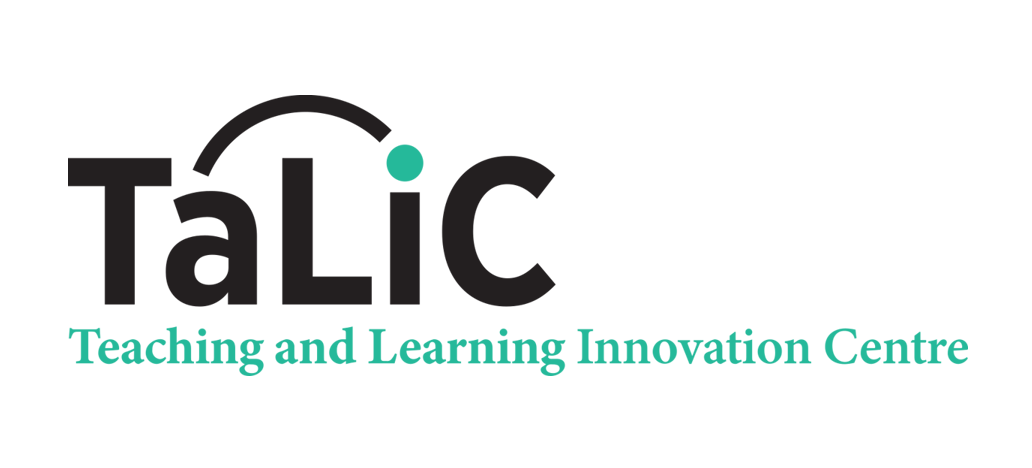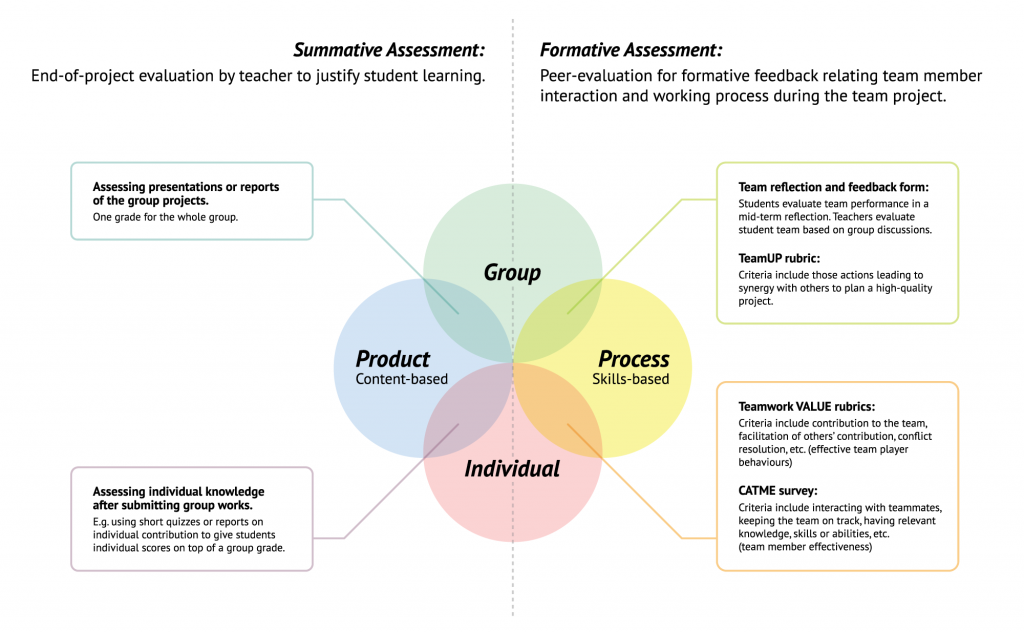Guides
Designing and assessing teamwork online
Overview - Benefits and Challenges
Overview – Benefits and challenges
Online teamwork can be defined as students working together in a small group that carries out collaborative work through electronic media (Chinowsky & Rojas, 2003). It is rewarding with many potential benefits but at the same time, it is also challenging. Other than the common issues such as free-riding and social loafing, the online learning environment also poses other unique challenges. Below we list out some of the benefits and challenges of online teamwork.
Benefits and challenges of online teamwork
Benefits |
Challenges |
|
|
Notes: (1) The table is compiled based on Koh & Hill (2009), Saghafian & O’Neill (2018), and Assessment Resources@HKU; (2) Items with * are particularly associated with teamwork in an online environment.
Assessment Task Design
Assessment task design
Having meaningful and motivating tasks for student teams is important. In both face-to-face and virtual modes, a good teamwork task needs to have the following characteristics: aligned with the course intended learning outcomes, achievable, encouraging collaboration and contributions from all students, and interesting and relevant to students.
 Tips for Task Design in an Online Environment
Tips for Task Design in an Online Environment
- Avoid easily divided tasks: It is better to have collaborative tasks that require each student to contribute and collaborate rather than tasks that can be easily divided into individual components (Davies, 2009). An example of a collaborative task is asking students to research on a topic, evaluate different perspectives, and develop their own views that integrate the different perspectives.
- Consider time and workload carefully: Though team tasks are typically more complex than individual assignments, it is important to carefully consider how much time students really need to complete the task. The calculation should include team establishment, information collection, communication, and decision making, plus the time spent on completing the deliverables (Nelson et al., 2007)
- Build in milestones or some low-stakes tasks: A big, high-stakes task at the end is intimidating. Building in milestones or a number of low-stakes tasks (e.g. an outline, an abstract, a storyboard) and providing student teams with feedback on them will greatly help students complete their final tasks successfully (Dijkstra et al., 2016)
- Make the final deliverables online friendly: Conventionally, student teams are often asked to make a presentation and submit a group report. In an online environment, creative ways of expression, such as digital narratives, videos, audios, infographics, and concept maps, can be encouraged. Examples of an online friendly deliverable is a Wikipedia page that requires students to collaboratively edit online or a digital exhibition assignment that requires students to design and create a virtual tour showcasing specific artefacts (see Technology-enhanced Learning website, HKU for the two examples: https://www.cetl.hku.hk/tel/videos/)
 Resources
Resources
- Davies, W. M. (2009). Groupwork as a form of assessment: Common problems and recommended solutions. Higher Education, 58, 563-584.
- Centre for Teaching Enhancement, Cornell University (2020). Examples of Collaborative Learning or Group Work Activities. Retrieved from: https://teaching.cornell.edu/resource/examples-collaborative-learning-or-group-work-activities
- Technology-enhanced Learning Website, HKU (2020). Videos. Retrieved from: https://www.cetl.hku.hk/tel/videos/
Group Setting
Group setting
Free riding, social loafing and, to another extreme end, hijacking are some of the dysfunctional behaviours that are most destructive to student learning in group project, because they discourage contribution from other members (Kapp, 2009). Rather that divorcing members or regrouping students, a better solution is to establish an effective strategy to prepare the students. See some effective tips for early stage of group formation from the literature (also applicable in virtual team).
 Tips for Group Formation (For Early Stage)
Tips for Group Formation (For Early Stage)
- Keeping group size small: A group of 4-5 members is effective. “The late Harvard psychology professor Richard Hackman noted that it takes only 10 conversations for every person on a team of five to touch base with everyone else, but that number rises to 78 for a team of 13.” (Ferrazzi, 2014). Some teachers would also prefer a size of five (odd number), so that the team could make decision by voting.
- Clarifying individual roles and responsibilities: Parker (2011) developed an effective team model consisting of four team player styles, i.e. Contributor (task-oriented), Collaborator (goal-oriented), Communicator (process-oriented) and Challenger (reflection-oriented). Students could do a pre-survey to understand their current primary team player style, role, responsibilities, strengths or weaknesses. (Parker Team Player Survey available at http://region21.org/downloads/2015Summer/TeamPlayerSurvey.doc )
- Setting team goals and contract/policy: After knowing the nature and individual team player styles, teams need to set goals and policies based on the combination of team members. Team goals should not only focus on accomplishing the team missions, but also address the personal development of each members (Lau & Kwong, 2016). Team contract is crucial to generate “shared cognition” among the members, so that everyone knows the appropriate process to perform (Salas, et al, 2008, p.541). (See a team contract example at http://www.pmtraining.com.tw/member_pmp/Team%20Contract%202.0.pdf)
- Setting ground rules for online discussion: Netiquette is a new term which combines the words “network” and “etiquette”. It is defined as a set of ground rules and regulation for behaving properly in cyberspace. Student working in virtual team should know the basic netiquette to develop effective collaboration and communication. (See details at http://www.albion.com/netiquette/index.html; examples of ground rules are available at https://blog.lucidmeetings.com/blog/using-ground-rules-improve-engagement-excellent-team-meetings)
- Doing individual and team readiness assurance tests: It is a good practice to test if the individual members and teams are ready to collaborate (e.g. sharing knowledge accurately) before performing as a team. Furthermore, these tests will serve as formative assessment and the teams will receive feedback to improve. (See details at https://learntbl.ca/what-is-tbl/ensuring-student-readiness/)
 Tips for Activities
Tips for Activities
Activities
Working Teams in the Classroom
Virtual Teams
Brainstorming Whiteboards
Flip chart boardsFree systems for brainstorming, team collaboration and project management systems:
- Miro (https://miro.com/online-whiteboard/)
- Slack (https://slack.com)
- MindMeister (https://www.mindmeister.com/)
Think-pair-share Post-its Padlet (https://padlet.com/) Poster presentation Flip chart boards New Google Sites (https://sites.google.com/new)
Mahara (https://learning.hku.hk/mahara/)Group discussion Face-to-face discussion Synchronous discussion
- Breakout rooms on Zoom
Asynchronous discussion
- Discussion board on Moodle
Writing reports
- Google Doc (not available in Mainland China)
- OneDrive share point
For more suggestions of online tools/resources, please refer to the websites of Technology Enhanced Learning (https://www.cetl.hku.hk/tel/technological-tools/) or Technology-Enriched Learning Initiative (https://teli.hku.hk/e-learning-resources/).
Remarks: Teachers should start with designing the activities/instruction before choosing a platform to facilitate it. Also, students need to be prepared when new platform is introduced, so it is not recommended to implement too many new platforms in a course.
 Resources
Resources
- Team-based learning https://learntbl.ca/what-is-tbl/
- Overview of the Readiness Assurance Process https://learntbl.ca/what-is-tbl/ensuring-student-readiness/
Teamwork Assessment and Rubric Designs
Teamwork assessment and rubric designs
To choose appropriate strategies to assess student learning in team (including virtual team), questions of three dimensions should be considered: Assessing team’s products (content-based, e.g. reports, presentation, etc.), the team process (skills-based, e.g. effectiveness of team members, team decision making, etc.) or both? Assessing individual or group as a whole? Formative or summative assessments? The below framework integrating the above three dimensions suggests some examples of assessment tasks/tools.
Marking Schemes for Group Work Assessment
Marking Schemes for Group Work Assessment
Team Reflection and Feedback Form
It is a teaching and assessment tool used to support and evaluate students learning teamwork skills. It is developed for health care education from Teamwork VALUE rubric. Hastie, C.R. (2018). ‘TeamUP’: An approach to developing teamwork skills in undergraduate midwifery students, Midwifery, 58, 93-95.
It is one of the 16 rubrics developed in the Valid Assessment of Learning in Undergraduate Education (VALUE) rubric project led by AAC&U (Association of American Colleges & Universities). This rubric assesses the teamwork of an individual student, not the team as a whole. It is designed to measure the quality of a process, rather than the quality of an end-product.
Britton, E., Simper, N., Leger, A., & Stephenson, J. (2017). Assessing teamwork in undergraduate education: a measurement tool to evaluate individual teamwork skills. Assessment & Evaluation in Higher Education, 42(3), 378-397
It is a web-based programme which provides tools for peer evaluation and helps instructor to gather information from students and provide feedback to student teams.
Based on two recent large-scale multi-disciplinary collaborative learning projects (Ganotice, & Chan , 2019; Lau, Chan, Wong, Kwong & Gibson, 2019), researchers identified that team conversations in online collaborative platforms (such as Moodle and LAMS) help to visualise the working process of virtual teams and to make the team decision making and development transparent to teachers and students. However, the interactions through the social media or face-to-face meetings are relatively difficult to observe and assess.
 Resources
Resources
- Team reflection and feedback form – students (Penn State University):
https://sites.psu.edu/schreyer/wp-content/uploads/sites/213/2012/07/6-team_reflection.pdf- Group assessment
https://ar.cetl.hku.hk/group.htm- TeamUP rubric:
It is a teaching and assessment tool used to support and evaluate students learning teamwork skills. It is developed for health care education from Teamwork VALUE rubric.Hastie, C.R. (2018). ‘TeamUP’: An approach to developing teamwork skills in undergraduate midwifery students, Midwifery, 58, 93-95. https://doi.org/10.1016/j.midw.2017.12.026- Teamwork VALUE rubrics:
It is one of the 16 rubrics developed in the Valid Assessment of Learning in Undergraduate Education (VALUE) rubric project led by AAC&U (Association of American Colleges & Universities). This rubric assesses the teamwork of an individual student, not the team as a whole. It is designed to measure the quality of a process, rather than the quality of an end-product. https://www.aacu.org/value/rubrics/teamworkBritton, E., Simper, N., Leger, A., & Stephenson, J. (2017). Assessing teamwork in undergraduate education: a measurement tool to evaluate individual teamwork skills. Assessment & Evaluation in Higher Education, 42(3), 378-397 https://doi.org/10.1080/02602938.2015.1116497- Comprehensive Assessment for Team-Member Effectiveness (CATME):
It is a web-based programme which provides tools for peer evaluation and helps instructor to gather information from students and provide feedback to student teams. https://info.catme.org/- Online teamwork rubric – teachers (Carnegie Mellon University)
https://www.cmu.edu/teaching/assessment/examples/courselevel-bycollege/hss/tools/jeria.pdf- Other examples of teamwork development and assessment at local universities:
- Ganotice, F.A. & Chan L. K. (2019). How can students succeed in computer-supported interprofessional team-based learning? Understanding the underlying psychological pathways using Biggs’ 3P model. Computers in Human Behavior, 91, 211–219.
- Lau, M., Chan, I., Wong, E. Y. W., Kwong, T. & Gibson, D. (2019). Helping students to build multicultural and multidisciplinary competences: A pilot of challenge-based collaborative Learning on a digital gamified platform. Journal of Education and Culture Studies, 3(3), 285–295. https://doi.org/10.22158/jecs.v3n3p285.
- Lau, P., Kwong, T., K, Chong., & Wong, E. (2014). Developing students’ teamwork skills in a cooperative learning project, International Journal for Lesson and Learning Studies, 3(1), 80–99.
- Zou, T.X.P., & Ko, E.I. (2012). Teamwork development across the curriculum for chemical engineering students in Hong Kong: Processes, outcomes and lessons learned. Education for Chemical Engineers, 7(3), 105–117.
References
References
- Chang, Y., & Brickman, P. (2018). When group work doesn’t work: Insights from students. CBE Life Sciences Education, 17(3), ar42. https://doi.org/10.1187/cbe.17-09-0199
- Chinowsky, P. S., & Rojas, E. M. (2003). Virtual teams: Guide to successful implementation. Journal of Management in Engineering, 19(3), 98–106.
- Dijkstra, J., Latijnhouwers, M., Norbart, A., & Tio, R.A. (2016). Assessing the “I” in group work assessment: State of the art and recommendations for practice. Medical Teacher, 38(7), 675–682.
- Ferrazzi, K. (2014). Getting virtual team right. Harvard Business Review, (December). https://hbr.org/2014/12/getting-virtual-teams-right
- Hastie, C., Fahy, K., & Parratt. J., (2014). The development of a rubric for peer assessment of individual teamwork skills in undergraduate midwifery students. Women and Birth, 27(3), 220–226. https://doi.org/10.1016/j.wombi.2014.06.003
- Kapp, E. (2009). Improving student teamwork in a collaborative project-based course. College Teaching, 57(3), 139–143.
- Koh, M-H., & Hill, J. R. (2009). Student perceptions of group work in an online course: Benefits and challenges. Journal of Distance Education, 23(2), 69–92.
- Lau, P., & Kwong, T. (2016). A community of practice to assess students’ teamwork skills in a team-based learning setting. Learning Communities Journal, 8(2), 93–106.
- Nelson, K., Kift, S., Creagh, T., & Quinn, C. (2007). Teamwork Protocol: Enhancing Transition at QUT: A Student Centred Approach to Learning. Retrieved from: https://eprints.qut.edu.au/42084/
- Parker, G. M. (2011). Team Players and Teamwork: New strategies for developing successful collaboration, completely updated and revised (2nd Edition). San Francisco: Jossey-Bass.
- Parratt, J., Fahy, K., Hutchinson, M., Lohmann, G., Hastie, C., Chaseling, M., & Obrien, K. (2015). Expert validation of a teamwork assessment rubric: A modified Delphi study. Nurse Education Today. 36, 77–85. https://doi.org/10.1016/j.nedt.2015.07.023
- Saghafian, M., & O’Neill, D.K. (2018). A phenomenological study of teamwork in online and face-to-face student teams. Higher Education, 75, 57–73.
- Salas, E., Cooke, N.J., & Rosen, M.A. (2008) On teams, teamwork, and team performance: Discoveries and developments, Human Factors: The Journal of the Human Factors and Ergonomics Society, 50, 540–541. http://hfs.sagepub.com/content/50/3/540
- Shea, V. (1994). Core rules of netiquette. Netiquette (Online ed., 32-45). San Francisco: Albion Books
- Sibley, J., & Ostafichuk, P. (2014). Getting started with team-based learning sterling, VA: Stylus.




